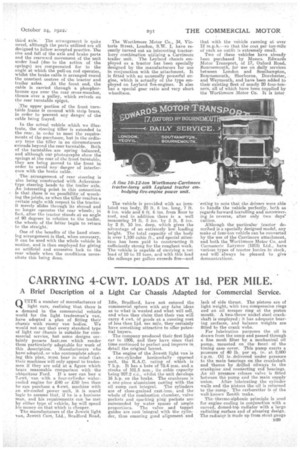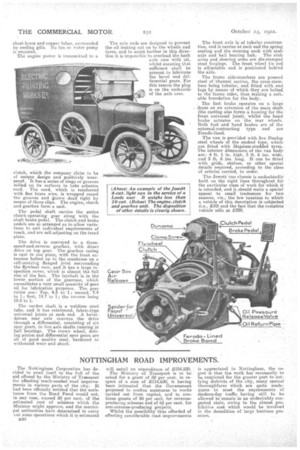CARRYING 4-CWT. LOADS AT lid. PER MILE.
Page 13

Page 14

If you've noticed an error in this article please click here to report it so we can fix it.
A Brief Description of a Light Car Chassis Adapted for Commercial Service.
UITE a number of manufacturers of light cars, realizing that there is a demand in the commercial vehicle world for the light tradesman's vari, have adopted a plan of fitting their chassis with roomy van bodies. We would not say that every standard type of light car chassis is suitable for commercial service, but some designs certainly possess featisres which render them particularly adaptable for work of this description. Manufacturers who have adopted, or who contemplate adopting this plan, must, bear in mind that their machines will only appeal to tradesmen if they are sold at a figure which bears reasonable comparison with the ubiquitous Ford. If a user can buy a 7-cwt. van with a four-cylinder watercooled engine for £40 or £50 less than lie can purchase a 4-cwt. machine with an air-cooled power unit, it is sound logic to assume that, if he is a business man, and his requirements can be. metby either type of vehicle, he will spend his money on that which is cheaper. The manufacturers of the Jewett light van, jowett Cars, Ltd., Bradford Road, Idle, Bradford, have not entered the commercial sphere with any false ideas as to what is wanted and what will sell, and when they claim that their van will carry 4 cwt. of goods at a running cost of less than 10. net mile, they certainly have something attractive to offer potential buyers.
The company produced their first light car in 1906, and they have since that time continued to perfect and improve in detail the original layout.
The engine of the Jowett light van is a -two-cylinder horizontally opposed unit, the R.A.C. rating of which is 7 h.p. It has a bore of 75.4 mm. and..a stroke of 101.5 mm. its cubic capacity being 907.2 c.c.. whilst the unit develops 16 h.p. on the brake. The crankcase is a one-piece aluminium casting with• the oil sump cast integral. The cylinders are of close-grained -cast-iron, and the whole) of the combustion chamber, valve rockets and sparking plug packets are surrounded by water spaces of ample proportions. The valve and tappet guides are cast integral with the cylinder, thus ensuring good alignment and
lack of side thrust. The pistons are of light weight, with two compression rings and an oil Scraper ring at the piston Mouth. A two-throw nickel steel crankshaft is employed ; it has adequate bear; big surfaces, and balance . weights are fitted to the crank webs.
• For lubrication purposes the oil is drawn from the sump and passed through a fine mesh filter by it mechanical oil pump, mounted on the front of the timing case cover. This pump exerts a pressure of 40 lb. per sq, in. at 2,000 r.p.m. .Oil isdelivered under pressure to the main -bearings on the crankshaft and thence by drilled oilways to the crankpins and connecting rod bearings. An Oil presaure release valve is fitted between the pump and the Main supply union. After lubricating the cylinder walls and the js istons the oil is returned to the sent?: The carburetter is of the
well-known Zenith make.
Tife-thermo-siphonic principle is used for engine cooling in conjunction with a curved, domed-top radiator with a large radiating surface and of pleasing design. The radiator is Made up from stout gauge sheet-brass and copper tubes, surrounded by cooling gills. No fan or water pump is required.
The engine poster is transmitted to a clutch, which the company claim to be of unique design and positively wearproof. It has is series of rings or grooves milled on its surfaces to take -asbestos cord. The cord, which is reinforced with fine brass wire, is wrapped round the grooves and drawn dead tight by means of three clips. The engine, clutch and gearbox form a unit.
The pedal shaft carries the entire clutchoperating gear along with the shaft brake pedal. The clutch and brake pedals are so arranged as to allow variations to suit individual requirements of reach, and are self-adjusting on the tread plate.
The drive is conveyed to a threespeed-and-reverse gearbox, with direct drive on top gear. The gearbox casing is cast in one piece, with the front extension bolted tip to the crankcase on a self-centring flanged joint surrounding the flywheel race, and it has a large inspection cover, which is almost the full size,of the box. The layahaft is in the lower, portion of the gearease, which eecessitates a very small quantity of gear oil for lubrication purposes. The gear ratios are: Top, 4.5 to 1; second, 7.4 to 1 ; first, 143 to 1; the reverse being 19.8 to 1.
The cardan shaft is a weldiess steel tube, and it has reinforced, fabric-type universal joints at each end. A bevel-. driven rear axle conveys the drive through a differential, consisting of six spur gears, to live axle shafts running in ball 'bearings. The crown wheel, driving pinion and differential spur gears are all of good quality steel, hardened to withstand wear and shock.
The axle ends are designed to prevent the oil leaking out on to the wheels and tyres, and to assist further in this, direction it is impossible to overload the back axle case with oil, whilst ensuring that sufficient ' shall be present to lubricate the bevel and differential gears. For this reason the plug is on the underside of the axle case.
The front axle is of tubular construction, and it carries at each end the spring seating and the steering neck with stubaxle and ball bearing hub: The stub axles and steering arms are die-stamped steel forgings. The front wheel tie rod. is adjustable and is positioned behind the axle.
The frame side-members are pressed steel of Channel section, the cross-members being tubular, and fitted with end lugs by means of which they are bolted' to the frame sides, thus making a suitable foundation for the body.
The foot brake operates on a large 'drum on an extension of the -main. shaft the casting also forms a housing for tbe front universal joint), whilst the hand brake actuates on the rear wheels. Both foot and hand brakes are of the external-contracting type and are Ferodo-lined.
The van is provided with five Dunlop steel wheels of the spoked type, which are fitted with Magnum-studded tyres.The interior dimensions of the van body are: 4 ft. 1 in. high, 3 ft. 6 ins, wide, and 3 ft. 6 ins. long. It can be fitted with grids, shelves, or other special details required, according to the classof articles carried, to order.
The Jorvett van chassis is undoubtedly built on the right lines throughout for the particular class of work for which it is intended, and it should make a special appeal to small tradesmen for two reasons, viz., the low taxation to which a vehicle of this description is subjected (i.e., £10) and the feet that the complete vehicle sells at £220.






























